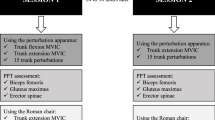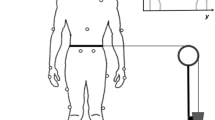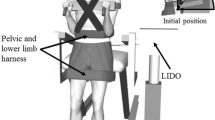Abstract
Purpose
To investigate if the recruitment of different regions within the lumbar extensor muscles in response to unexpected perturbations depends on trunk posture.
Methods
In a semi-seated posture, healthy adult participants experienced unexpected posterior-anterior trunk perturbations in three different postures: neutral, trunk flexion and left trunk rotation. High-density surface electromyography was used to identify the regional distribution of activation within the lumbar erector spinae muscles. The effect of posture and side (left vs right) on muscle activity and centroid coordinates was investigated at baseline and in response to perturbations.
Results
Higher muscle activity was observed in trunk flexion compared to neutral and rotation postures at baseline (multiple p < 0.001) and in response to the perturbation (multiple p < 0.01). At baseline, the centroid of the electromyographic amplitude distribution was localized more medially in trunk flexion compared to trunk neutral posture (p = 0.003), while activation was localized more laterally in response to the perturbation (multiple p < 0.05). When the trunk was rotated, the electromyographic amplitude distribution was localized more cranially on the left than the right side, both at baseline (p = 0.001) and in response to the perturbation (p = 0.001). Finally, a more lateral location of the centroid on the left side in rotation compared to neutral posture was observed in response to the perturbation (multiple p < 0.001).
Conclusions
Regional differences in the distribution of electromyographic amplitude indicate that different muscle regions were recruited in different trunk postures and in response to perturbations, possibly based on regional mechanical advantage of the erector spinae muscle fibers.






Similar content being viewed by others
Abbreviations
- ANOVA:
-
Analysis of variance
- EMG:
-
Electromyography
- HDsEMG:
-
High-density surface electromyography
- MVIC:
-
Maximal voluntary isometric contractions
- RMS:
-
Root mean square
- SD:
-
Standard deviation
References
Abboud J, Nougarou F, Lardon A, Dugas C, Descarreaux M (2016) Influence of lumbar muscle fatigue on trunk adaptations during sudden external perturbations. Front Hum Neurosci 10:576. https://doi.org/10.3389/fnhum.2016.00576
Abboud J, Kuo C, Descarreaux M, Blouin JS (2020) Regional activation in the human longissimus thoracis pars lumborum muscle. J Physiol 598:347–359. https://doi.org/10.1113/jp278260
Afsharipour B, Petracca F, Gasparini M, Merletti R (2016) Spatial distribution of surface EMG on trapezius and lumbar muscles of violin and cello players in single note playing. J Electromyogr Kinesiol 31:144–153. https://doi.org/10.1016/j.jelekin.2016.10.003
Besomi M et al (2019) Consensus for experimental design in electromyography (CEDE) project: Electrode selection matrix. J Electromyogr Kinesiol 48:128–144. https://doi.org/10.1016/j.jelekin.2019.07.008
Bogduk N (2005) Clinical anatomy of the lumbar spine and sacrum. Elsevier Health Sciences
Butler JE, Gandevia SC (2008) The output from human inspiratory motoneurone pools. J Physiol 586:1257–1264. https://doi.org/10.1113/jphysiol.2007.145789
Dupeyron A, Perrey S, Micallef J-P, Pélissier J (2010) Influence of Back Muscle Fatigue on Lumbar Reflex Adaptation during Sudden External Force Perturbations. J Electromyograp Kinesiol 20:426–432
Falla D, Gizzi L, Tschapek M, Erlenwein J, Petzke F (2014) Reduced task-induced variations in the distribution of activity across back muscle regions in individuals with low back pain. Pain 155:944–953. https://doi.org/10.1016/j.pain.2014.01.027
Gallina A et al (2022) Consensus for experimental design in electromyography (CEDE) project: High-density surface electromyography matrix. J Electromyograp Kinesiol 64:102656. https://doi.org/10.1016/j.jelekin.2022.102656
Harriss AB, Brown SH (2015) Effects of changes in muscle activation level and spine and hip posture on erector spinae fiber orientation. Muscle Nerve 51:426–433
Henneman E (1981) Recruitment of motoneurons: the size principle Motor unit types, recruitment and plasticity in health and disease:26–60
Hill AV (1953) The mechanics of active muscle. Proc R Soc Lond B Biol Sci 141:104–117. https://doi.org/10.1098/rspb.1953.0027
Hodges PW, Bui BH (1996) A comparison of computer-based methods for the determination of onset of muscle contraction using electromyography. Electroencephalogr Clin Neurophysiol 101:511–519. https://doi.org/10.1016/s0013-4694(96)95190-5
Hodges PW, Coppieters MW, MacDonald D, Cholewicki J (2013) New insight into motor adaptation to pain revealed by a combination of modelling and empirical approaches. Eur J Pain 17:1138–1146. https://doi.org/10.1002/j.1532-2149.2013.00286.x
Hudson AL, Gandevia SC, Butler JE (2019) A principle of neuromechanical matching for motor unit recruitment in human movement. Exerc Sport Sci Rev 47:157–168
Kumar S, Narayan Y, Garand D (2001) Isometric axial rotation of the trunk in the neutral posture. Eur J Appl Physiol 86:53–61. https://doi.org/10.1007/s004210100510
Larivière C, Forget R, Vadeboncoeur R, Bilodeau M, Mecheri H (2010) The effect of sex and chronic low back pain on back muscle reflex responses. Eur J Appl Physiol 109:577–590. https://doi.org/10.1007/s00421-010-1389-7
Macintosh JE, Bogduk N (1987) 1987 Volvo award in basic science. The Morphology of the Lumbar Erector Spinae Spine 12:658–668. https://doi.org/10.1097/00007632-198709000-00004
Macintosh JE, Valencia F, Bogduk N, Munro RR (1986) The morphology of the human lumbar multifidus. Clini Biomech 1:196–204
Malakoutian M, Sanchez CA, Brown SHM, Street J, Fels S, Oxland TR (2022) Biomechanical properties of paraspinal muscles influence spinal loading-a musculoskeletal simulation study. Front Bioeng Biotechnol 10:852201. https://doi.org/10.3389/fbioe.2022.852201
McGill SM, Santaguida L, Stevens J (1993) Measurement of the trunk musculature from T5 to L5 using MRI scans of 15 young males corrected for muscle fibre orientation. Clin Biomech (bristol, Avon) 8:171–178. https://doi.org/10.1016/0268-0033(93)90011-6
McGill SM, Hughson RL, Parks K (2000) Changes in lumbar lordosis modify the role of the extensor muscles. Clin Biomech 15:777–780
McGill S (2015) Low back disorders: evidence-based prevention and rehabilitation. Human Kinetics,
Ng JK, Parnianpour M, Richardson CA, Kippers V (2001) Functional roles of abdominal and back muscles during isometric axial rotation of the trunk. J Orthop Res 19:463–471. https://doi.org/10.1016/s0736-0266(00)90027-5
Park RJ, Tsao H, Cresswell AG, Hodges PW (2014) Anticipatory postural activity of the deep trunk muscles differs between anatomical regions based on their mechanical advantage. Neuroscience 261:161–172. https://doi.org/10.1016/j.neuroscience.2013.12.037
Pruszynski JA, Scott SH (2012) Optimal feedback control and the long-latency stretch response. Exp Brain Res 218:341–359. https://doi.org/10.1007/s00221-012-3041-8
Radebold A, Cholewicki J, Panjabi MM, Patel TC (2000) Muscle response pattern to sudden trunk loading in healthy individuals and in patients with chronic low back pain. Spine 25:947–954
Readi NG, Rosso V, Rainoldi A, Vieira TM (2015) Do sweep rowers symmetrically activate their low back muscles during indoor rowing? Scand J Med Sci Sports 25:e339-352. https://doi.org/10.1111/sms.12319
Ringheim I, Indahl A, Roeleveld K (2019) Reduced muscle activity variability in lumbar extensor muscles during sustained sitting in individuals with chronic low back pain. PLoS ONE 14:e0213778. https://doi.org/10.1371/journal.pone.0213778
Serafino F, Trucco M, Occhionero A, Cerone GL, Chiarotto A, Vieira T, Gallina A (2021) Understanding regional activation of thoraco-lumbar muscles in chronic low back pain and its relationship to clinically relevant domains. BMC Musculoskelet Disord 22:1–12
Shahvarpour A, Shirazi-Adl A, Mecheri H, Larivière C (2014) Trunk response to sudden forward perturbations—effects of preload and sudden load magni tudes, posture and abdominal antagonistic activation. J Electromyogr Kinesiol 24:394–403. https://doi.org/10.1016/j.jelekin.2014.03.007
Todorov E, Jordan MI (2002) Optimal feedback control as a theory of motor coordination. Nat Neurosci 5:1226–1235
Tucker K, Falla D, Graven-Nielsen T, Farina D (2009) Electromyographic mapping of the erector spinae muscle with varying load and during sustained contraction. J Electromyogr Kinesiol 19:373–379. https://doi.org/10.1016/j.jelekin.2007.10.003
Tveit P, Daggfeldt K, Hetland S, Thorstensson A (1994) Erector spinae lever arm length variations with changes in spinal curvature. Spine 19:199–204. https://doi.org/10.1097/00007632-199401001-00015
Vieira TM, Merletti R, Mesin L (2010) Automatic segmentation of surface EMG images: Improving the estimation of neuromuscular activity. J Biomech 43:2149–2158. https://doi.org/10.1016/j.jbiomech.2010.03.049
Funding
This research received funding from Natural Sciences and Engineering Research Council of Canada (NSERC) (RGPIN-2020-06076).
Author information
Authors and Affiliations
Corresponding author
Ethics declarations
Conflict of interest
There is no conflict of interest.
Additional information
Communicated by Toshio Moritani.
Publisher's Note
Springer Nature remains neutral with regard to jurisdictional claims in published maps and institutional affiliations.
Rights and permissions
Springer Nature or its licensor (e.g. a society or other partner) holds exclusive rights to this article under a publishing agreement with the author(s) or other rightsholder(s); author self-archiving of the accepted manuscript version of this article is solely governed by the terms of such publishing agreement and applicable law.
About this article
Cite this article
Abboud, J., Ducas, J., Marineau-Bélanger, É. et al. Lumbar muscle adaptations to external perturbations are modulated by trunk posture. Eur J Appl Physiol 123, 2191–2202 (2023). https://doi.org/10.1007/s00421-023-05223-2
Received:
Accepted:
Published:
Issue Date:
DOI: https://doi.org/10.1007/s00421-023-05223-2




